One More Mary Oliver Monday
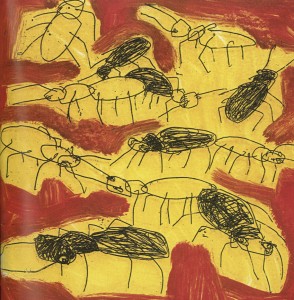 In Praise of Craziness, of a Certain Kind by Mary Oliver
In Praise of Craziness, of a Certain Kind by Mary Oliver
On cold evenings
my grandmother,
with ownership of half her mind–
the other half having flown back to Bohemia–
spread newspapers over the porch floor
so, she said, the garden ants could crawl beneath,
as under a blanket, and keep warm,
and what shall I wish for, for myself,
but, being so struck by the lightning of years,
to be like her with what is left, that loving.
(image from: A Whole World, by Couprie and Louchard)
Living and Dying
from The Tibetan Book of Living and Dying, by Sogyal Rinpoche:
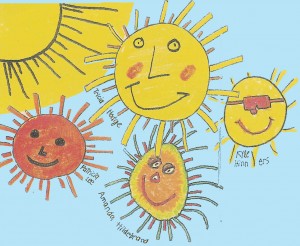 “Above all, be at ease, be as natural and spacious as possible. Slip quietly out of the noose of your habitual anxious self, release all grasping, and relax into your true nature.
“Above all, be at ease, be as natural and spacious as possible. Slip quietly out of the noose of your habitual anxious self, release all grasping, and relax into your true nature.
“Think of your ordinary, emotional, thought-ridden self as a block of ice or a slab of butter left out in the sun. If you are feeling hard and cold, let this aggression melt away in the sunlight of your meditation.
“Let peace work on you and enable you to gather your scattered mind…and awaken in you the awareness and insight of Clear Seeing. You will find your negativity disarmed…and your confusion evaporating slowing like mist into the vast and stainless sky of your absolute nature.”
(image from: kidsforsavingearth.org)
Precious and Impermanent
 I just got word that one of my fellow Dedicated Practitioners, Steve Y., suffered a stroke over the weekend. An MRI was performed, which revealed advanced and terminal cancer. Preparations are being made for hospice care.
I just got word that one of my fellow Dedicated Practitioners, Steve Y., suffered a stroke over the weekend. An MRI was performed, which revealed advanced and terminal cancer. Preparations are being made for hospice care.
Steve is a Resident Caretaker at Spirit Rock and one of the sweetest, kindest, most tender people I’ve ever met.
May we all see the preciousness of each of our lives right here, right now….and may we know the truth of impermanence.
May all Beings be Peaceful.
Is This What You Want?
From U Tejaniya, the meditation teacher at Shwe Oo Min monastery in Yangon, where I’ll be staying for a couple of weeks at the end of our trip in January:
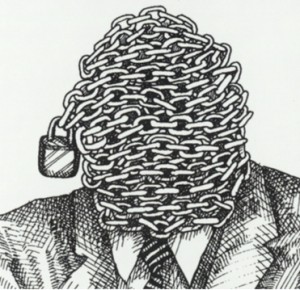 “When does the mind feel tightness or tension?
“When does the mind feel tightness or tension?
“There is tension when the mind wants something other than what is happening or when the mind rejects what is happening.
“Defilements [impediments to peace] don’t want to let things be as they are; they want something to happen, they want results, or they want to control what is happening and they’ll force, focus, create, or restrict to get what they want.”
(image from: Creative What Pack, by Roger von Oech)
Knowing That You Know
 Last night the Dharma Seed KM group listened to a wonderful talk by Phillip Moffitt called The Refuge in Awareness. In it, he discusses the subtle nature of awareness, gives very helpful directions on how to take awareness itself as an object of meditation and reflects deeply on what it means to “rest” in awareness. I highly recommend listening it. (click here)
Last night the Dharma Seed KM group listened to a wonderful talk by Phillip Moffitt called The Refuge in Awareness. In it, he discusses the subtle nature of awareness, gives very helpful directions on how to take awareness itself as an object of meditation and reflects deeply on what it means to “rest” in awareness. I highly recommend listening it. (click here)
Phillip often uses the phrase “knowing that you know” to describe this quality of awareness. In Dancing with Life, he lists three empowerments that come from this knowing:
“First, only by knowing that you know will you have a base of insight that will allow you to realize the remaining insights. Otherwise, you will get stuck in your thoughts and emotions…
“Second, by enabling you to integrate the insights into your daily existence, knowing that you know allows the dharma to make a substantial transformation in how you live your life right now….
“Finally, knowing that you know is an end in itself. Ajahn Sumedho describes this state as ‘Buddha knows the dharma,’ when your true nature is in touch with itself. The result is what I call an ’embodied presence’: You become a person who walks your talk because you’re consciously willing to bear your suffering. With the integration of each truth, your wisdom grows and this sense of embodied presence becomes stronger and stronger.”
(image from: Napo Tarot)
Mary Oliver Monday, Again
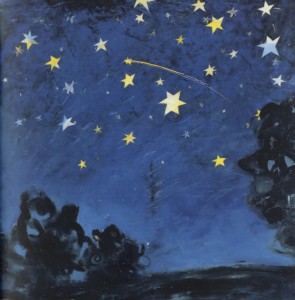 What Is There Beyond Knowing by Mary Oliver
What Is There Beyond Knowing by Mary Oliver
What is there beyond knowing that keeps
calling to me? I can’t
turn in any direction
but it’s there. I don’t mean
the leaves’ grip and shine or even the thrush’s
silk song, but the far-off
fires, for example,
of the stars, heaven’s slowly turning
theater of light, or the wind
playful with its breath;
or time that’s always rushing forward,
or standing still
in the same–what shall I say–
moment.
What I know
I could put into a pack
as if it were bread and cheese, and carry it
on one shoulder,
important and honorable, but so small!
While everything else continues, unexplained
and unexplainable. How wonderful it is
to follow a thought quietly
to its logical end.
I have done this a few times.
But mostly I just stand in the dark field,
in the middle of the world, breathing
in and out. Life so far doesn’t have any other name
but breath and light, wind and rain.
If there’s a temple, I haven’t found it yet.
I simply go on drifting, in the heaven of the grass and the weeds.
(image from: A Whole World, by Couprie and Louchard)
On My Way to Mandalay
I don’t leave for Burma until January 7, but the tickets are booked and planning is well underway. One of the things we’ll be doing is taking a ferry to Mandalay:
Once we’re there, here’s some of what we’ll see:
Just Stay on the Path
More from Dancing with Life, by Phillip Moffitt:
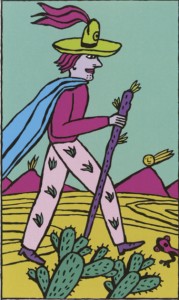 “If you continue to practice, the day will come when you realize that the only way life makes any sense with its endless changing cycle of gain and loss, pain and pleasure, is to view it as practice.
“If you continue to practice, the day will come when you realize that the only way life makes any sense with its endless changing cycle of gain and loss, pain and pleasure, is to view it as practice.
“Treating the Eightfold Path as integral practice transforms your everyday life….Skillful living becomes your measure of success, instead of how often you get what you want.
“This is a much better way to view your life! You are more relaxed, flexible, and you even experience more enjoyment. Some of your worldly goals will fall away or diminish in importance, but many will remain, although they are constantly changing.
“The radical difference is that your inner attitude shifts and how you manifest moment by moment as you go about attaining your worldly goals is dramatically different. Your experience of life itself is changed.”
(image from: Kitty Kahane Tarot)
Talk, Talk, Talk
In Chapter 19 of Dancing with Life, Phillip Moffitt reflects on the Eightfold Path, which “is not a list of what to do if you want to become a good person. Rather, it is a matrix of behavior, understanding, and practice for finding peace of mind and meaning in your life.”
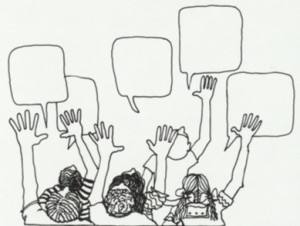 One of these eight “folds” is Right Speech, “which involves saying what is not only true and useful but also timely…”
One of these eight “folds” is Right Speech, “which involves saying what is not only true and useful but also timely…”
“This may sound simple to you, but just wait until you actually try practicing right speech!
“You will discover that much of the time you spend talking serves little or no purpose for you or others. It is simply your brain discharging the pressure you feel through casual, fairly random utterances or running commentary on what you are currently experiencing.
“You quickly discover that speech actually drains you of energy and often creates situations that then demand more of your attention.
“Or you many discover that much of your speech is just a space filler to avoid silence or for the purpose of being entraining when it is not really very interesting to you or the other person.”
Uh oh.
(image from: Creative Whack Pack, by Roger von Oech)
How to Dance
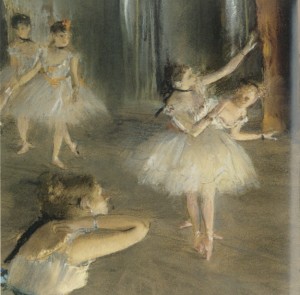 We had a great discussion at the Dancing with Life KM group last night. We’ve just started reading the last section of the book, which focuses on the Fourth Noble Truth: the Way Leading to the End of Suffering. This is where we look at the Buddha’s guide for purifying the mind: the Noble Eightfold Path, which is the training in ethical behavior (sila), mindfulness and concentration (samadhi) and wisdom (panna).
We had a great discussion at the Dancing with Life KM group last night. We’ve just started reading the last section of the book, which focuses on the Fourth Noble Truth: the Way Leading to the End of Suffering. This is where we look at the Buddha’s guide for purifying the mind: the Noble Eightfold Path, which is the training in ethical behavior (sila), mindfulness and concentration (samadhi) and wisdom (panna).
“As you have seen through practicing mindfulness, your thoughts, words, and actions have consequences; they condition future moments in your life that will create either suffering or nonsuffering.
“For this reason….you cultivate ethical behavior (sila) so that your mind is not disturbed by guilt and denial.
“You develop mindfulness and concentration (samadhi) both in meditation and life so that your mind is steady and awake during all your daily activities so that you are present to make choices that do not create dukkha (suffering).
“And finally, you cultivate wisdom (panna) through meditation, observation, and reflection so that you develop the discernment to know what brings happiness and what causes suffering. All three–sila, samadhi, and panna–act together to purify the mind.”
I have to admit that “purifying the mind” is not what I thought I was getting into when I started meditation. “Purifying” sounds painful! It sounds “puritanical” and conjures up all kinds of abusive messages about being “dirty” and “sinful.”
But that’s not what this is about.
“Purification of the mind brings the steadiness and the clarity that allows insight to arise. Both purification and insight are necessary for genuine liberation.
“Purification practice without insight and compassion leads to fundamentalism, a fixed view about right and wrong. It lends itself to superstition, to condemnation of others, and to imposing your will on others.
“Likewise, insight without purification can result in nihilism or hedonism, self-serving ignorance, and lack of accountability such that any behavior can be justified or rationalized.
“Even when you have profound insights they cannot be integrated into your life if your mind is unpurified. You are unable to move to a new level of consciousness, and you continue to cause suffering for yourself and others…
“By contrast, the act of skillfully dancing with life through the Noble Eightfold Path brings about the precursors moments of well-being and freedom that move you forward to full cessation [freedom from suffering].”
(image from: The Rehearsal Onstage (detail), by Edgar Degas)




